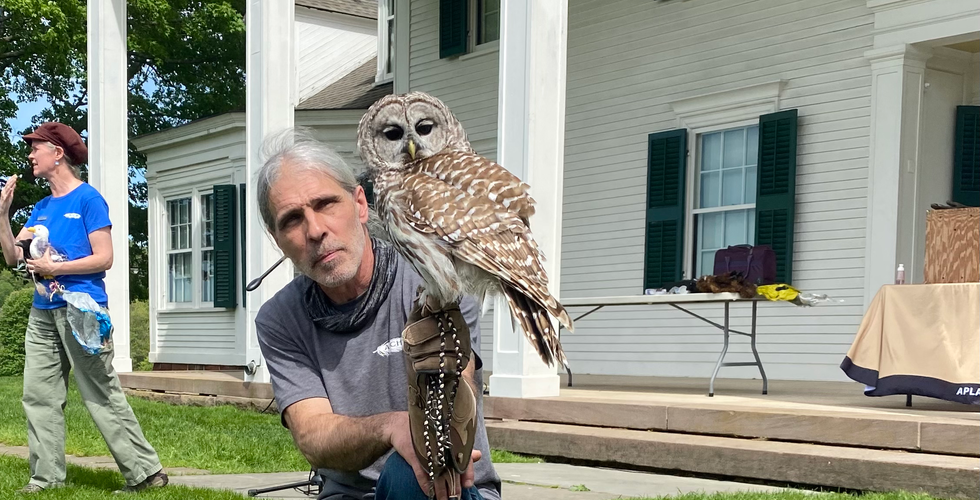FLT Owls at Hillstead
Christine Cummings and Todd Secki from A Place Called Hope, a Birds of Prey rehabilitation Center in Killingworth, introduced four species of owls to the multi-generational crowd at Hillstead Museum. On the lawn, under a blue, cloudless sky, we gazed in fascination and the owls gazed back.
The first owl was a tiny Eastern red-phase Screech owl named Kokopelli who had flown into a window about 12 years ago. He hadn’t gotten the help he needed so his wing bone fused incorrectly, and he found his way to A Place Called Hope. We learned that the tufts on top of his head were not ears, but mood indicators. When he is upset, the tufts lie flat. As he was paraded around to the audience by his handler, his tufts were perky—a good sign. He eats insects and amphibians. Screech owls were misnamed by James Audubon because while observing them, he heard a screech, but didn’t realize it hadn’t come from the little so-called Screech owl but a Barn Owl. The Screech Owl emits a high-pitched, melodic whinny.
An interesting fact about owls is that they can detect ultraviolet light and because the urine of their prey—rodents—reflects ultraviolet light, they are able to hunt them efficiently. But they cannot see glass which is why they fly into windows sometime and injure themselves. Christine advised us to put ultraviolet stickers on windows.
The owl I wanted to see was the Great Horned named Amber because I once had a vivid dream about a Great Horned owl who alighted in complete silence into my open bedroom window.
Amber fell at two weeks old and could have been re-nested, but the Nature Center director who found her thought she could be an ambassador for his center so he kept her under his desk in a box for nine weeks. She couldn’t be returned to the wild because by then she was too dependent on humans and probably wouldn’t have survived .
She has a wing span of three and a half feet which she showed off for us.
Great Horned Owls have a sharp curved beak used to eat and feed their babies in bite sized portions. Their talons catch prey and can usually break the spine of their prey with one foot due to their strength.
The female lays eggs in mid-February and sits on them to keep them at 93 degrees, while the male owl hunts. They eat rats, mice, snakes, skunks and sometimes cats. So be careful letting your cat out at night. Large owls also prey on smaller owls.
Zen the Barred owl was kept as pet by a family, but owls are not social and don’t bond with humans well. The family tried to let him go, but he was so imprinted on humans, he wouldn’t leave. His chances of surviving in the wilderness were slim.
The last owl was a white Snowy owl named Otsi. Snowy owls spend time in the Arctic and visit further South in the winter. They are crepuscular, which means they hunt during both dawn and dusk primarily. Known as the “unicorn” of owls because they are rare, they are followed and popular with bird watchers. Otsi fled people following him and was hit by a car. He lost part of a wing because of it.
You can visit the website for A Place Called Hope https://www.aplacecalledhoperaptors.com/ and adopt one of the birds of prey. I adopted Amber, the Great Horned Owl.














Yorumlar